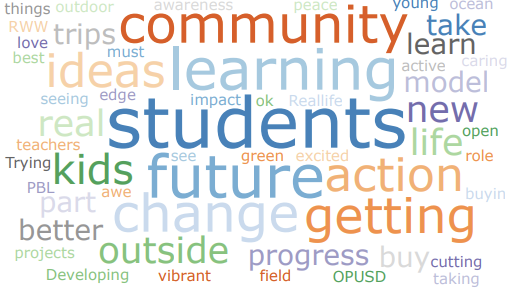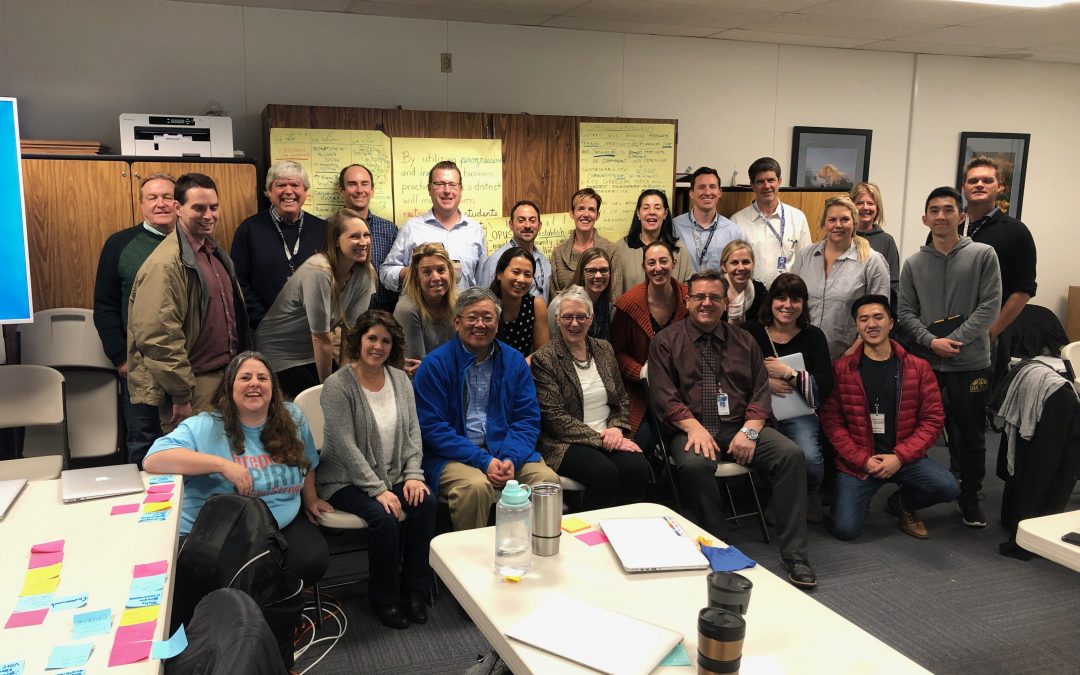By. Jay Greenlinger, Oak Park Unified School District
Sustainability is embedded in the way we do things at Oak Park Unified School District (OPUSD). Our solar arrays provide more than 80% of our electricity, and our kitchens create scratch cooked meals. We have received numerous accolades for our sustainable facilities, operations, and nutrition programs. In 2013, OPUSD became the first California school district to be recognized as a U.S. Department of Education Green Ribbon District Awardee. In 2018, we were named by the Center for Green Schools at the U.S. Green Building Council as a Best of Green Schools Award winner.
As a leader in sustainable school practices, OPUSD is no stranger to green school best practices. However, until last year we felt like we were our own – we didn’t have other schools to lean on when we had a question or wanted to talk through an idea. In stepped the Green Schools National Network (GSNN), who offered us the chance to become a Catalyst District. Catalyst Schools and Districts are working with GSNN to identify the best of the best in sustainability best practices. These select schools and districts will eventually become replication hubs, places where other schools can come and learn from leaders and educators before returning home to implement some of the practices they were introduced to. We now stand at the precipice of truly meaningful work – defining policies, programs, and practices that other schools can use as models for their own sustainability initiatives.
To kick-off participation as a Catalyst District, OPUSD held a Sustainability Leadership Summit this past January with more than 30 school and district administrators, teachers, parents, students, Board members, and community members in attendance. This energetic group spent one and a half days setting OPUSD’s course for sustainability.
Entering this summit, our greatest unanswered question was, “How do we meaningfully integrate sustainability into our curriculum?” After our summit, OPUSD was ready to answer this question and fulfill our responsibility as a Catalyst District.
Led by GSNN Executive Director Jenny Seydel, the leadership summit encouraged us to reflect on our current practices. I, along with Director of Sustainability, Maintenance, and Operations Brendan Callahan, kicked off the summit with a thorough review of everything we have done to-date in the name of sustainability. This was a lengthy presentation, leading to comments such as “I didn’t know we have lithium ion batteries that store electricity!” and “We have bioswales on all of our campuses?” This realization, that education needs to start with staff, provided us with our first concrete next step – educate our staff and parents on the many sustainable aspects of our schools.
We then moved on to define “sustainability” at OPUSD. We studied the different types of systems that exist in schools and in the district and named the ways that we use ‘command and control’ vs. ‘adaptive’ operating systems for decision-making. Participants arrived at the conclusion that both types of decision-making processes are necessary to move change forward.
With a common understanding of “sustainability” and the systems that lead to change, we then posed the question: “How might OPUSD improve its work related to education for sustainability?” Instead of listing the scores of responses to this question, I created a visual representation of the answers.

As with all things at OPUSD, students are at the center of everything that we do. The word cloud above is further proof of that important OPUSD core value. Our group agreed that, moving forward, we must keep students as the central thinkers and doers for us to meaningfully integrate sustainability into the curriculum.
Our group was excited to imagine the possibilities, and we took inspiration from Alison Suffet Diaz, Executive Director of Environmental Charter Schools (ECS). Alison shared story of ECS, a Catalyst District that is about 25 miles, yet a world away, from Oak Park. Serving some of the most impacted areas in Los Angeles, ECS boasts incredible outcomes for students. We were inspired by the interdisciplinary work students do at ECS. Do yourself a favor and spend one minute watching this video about ECS.
Now that we had a strong understanding of what we had already accomplished, defined what sustainability means to our district, and witnessed an example of what we might become, we set out to formulate our goals. Every summit attendee read a foundational article on change, sustainability, or curriculum. Through countless conversations and post-it notes, we arrived at our two overarching goal statements:
- Driven by the United Nations Sustainable Development Goals, in partnership with students, staff, parents, and the community, OPUSD will develop and utilize progressive and innovative practices in the development of empowered, thoughtful global citizens.
- Authentic sustainability education will be interwoven into all aspects of teaching and learning throughout the school community and will integrate student participation and leadership to inspire global stewardship.
The leadership summit was hard work. Throughout that day and a half, there was deep thought and conversation. Each day, participants left the room tired from the challenge of dreaming our future. But now, the real work begins. We set off to achieve these two goals, which will require continued collaboration, questioning, listening, and challenging ourselves and our current practices to maximize interdisciplinary learning with sustainability at its core. As our students study bioswales, renewable energy sources, the use of native plant life, and poison free pest management, our staff will use the phrase, “The campus is a curriculum,” to guide our work.
Of course, it would be foolhardy to try and provide all the details of our summit, and it would be even more so to try and list all our ambitious instructional goals. Instead, I will leave you with a question we posed to our summit attendees and a visualization of their responses. It has always been a good time to be a student at Oak Park. Below you’ll see why it’s never been a better time to be an Oak Park student.
I am excited about….

Author Bio
Dr. Jay Greenlinger is the Director of Curriculum and Instruction at Oak Park Unified School District. Jay’s education career began at 15, when he became a camp counselor. He received a B.A. in Psychology from the University of Massachusetts, Amherst, an M.A. in Elementary Education from Pepperdine University, and an M.A. in School Administration and a Doctorate in Educational Leadership from California State University, Northridge. He is a former teacher, principal, and technology director. If Jay’s not at work, you’ll most likely find him playing outside with his wife Lisa – an elementary teacher – and their four young children.

